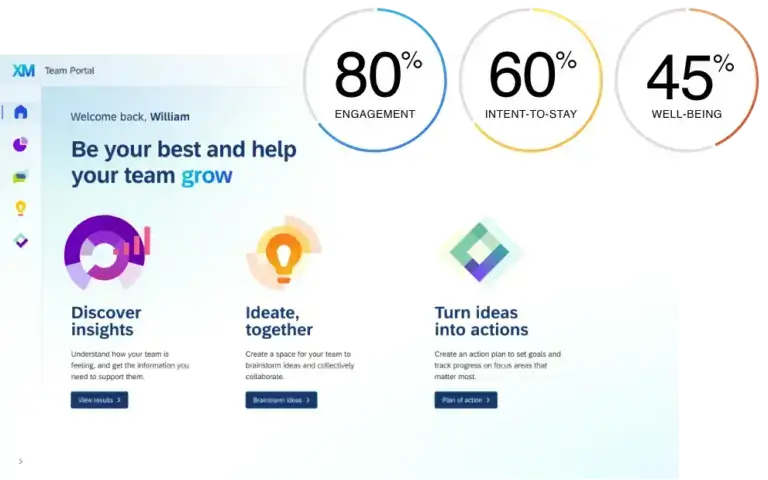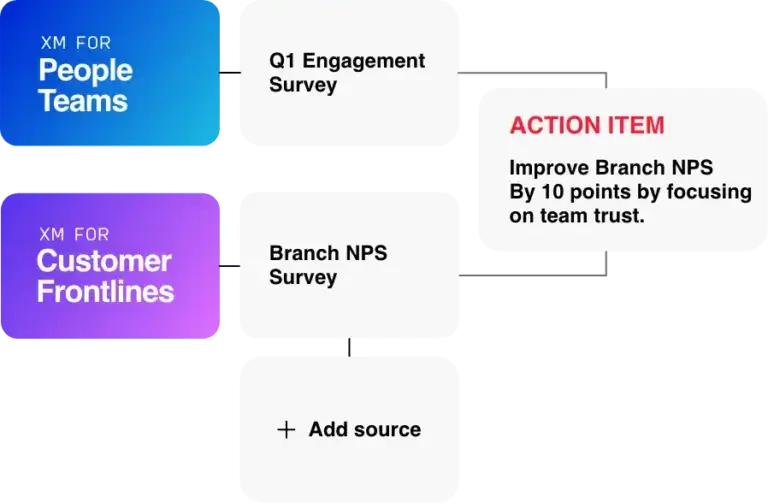Written by: Ruth D’Alessandro
Fact Checked by: Aaron Carpenter
In this article we’ll look at what people intelligence is, how it works, and the benefits of using it. We’ll also suggest suitable tools to enhance your people processes and make better decisions.
It’s a digital-first world. This means that a core part of an organization is the right digital technology to meet its users’ needs, learn from users’ behaviors, and provide a seamless modern digital experience through every channel – efficiently and intuitively.
Yet despite this, it’s never been more important – and difficult – to understand how your people actually feel.
The locked-down, disconnected working practices of the pandemic highlighted the very human need to be connected with our teams. Suddenly we could see the struggles of parents trying to work while homeschooling their children; new hires who should be enjoying their onboarding experience in the office with their teammates peering forlornly at a screen on a Zoom call; and managers, caught in the middle of their teams and senior leaders, trying to make the best decisions for their teams to deliver business expectations, yet lacking critical insight.
The post-pandemic world of work is a challenging time, and there’s a critical need for in-the-moment, organization-wide insights.
In other words, people intelligence.
Watch demo: Bring all of your data together with Qualtrics CrossXM
What is people intelligence?
People intelligence is effectively the amalgamation of every aspect of feedback and insight across the whole employee experience spectrum, giving leaders and managers the precise data points, strategies, insights, and dashboards that they need to take action and make meaningful change happen.
Why is people intelligence important?
Typically, organizations take a disconnected approach to their employee experience. They may have traditional surveys – possibly only the annual engagement survey – and if you’re lucky, some kind of employee experience software. But all this approach does is offer fragments of the overall picture. Consequently, most measures to improve employee experience are also fragmented because this approach doesn’t dig deep into understanding how their employees truly feel across their whole lifecycle, what their in-the-moment needs are, and where the challenges present themselves.
The capability of good people intelligence is important because it completely redefines how organizations look at their employee experience. For example, rather than waiting for employees to tell leaders they’re burned out, using surveys (maybe even that annual engagement survey), people intelligence lets leaders pick up on warning signs of burnout before it even happens. Leaders can find out what is causing burnout at every level, how they can act to stop it, and how the organization compares with others across the industry.
These intelligent capabilities mean that you can raise your employee experience to the next level.
How does people intelligence work?
Think of people intelligence as a singular, central hub for all things employee experience:
- Engagement
- Lifecycle
- Analytics
Workforce analytics, people analytics, candidate experience, and employee engagement solutions are all part of a people intelligence solution, which uses advanced technology to build engaged, high-performance teams, improve manager effectiveness, and understand experiences at scale and across touchpoints, helping you make timely business decisions.
Some people intelligence suites incorporate generative AI and machine learning capabilities. These empower organizations to look beyond data and understand crucial context – the where, the why and the how – and target improvements where they are most needed.
An example of a people intelligence solution is XM® for People Teams. It provides every single employee, manager, leader and team with actionable insights, strategies, and tools to take employee experiences across the whole organization to the next level.

The benefits of using people intelligence in your business operations
Organizations need to run smoothly and efficiently. To achieve this, they want to pinpoint quickly where the biggest friction points are in their businesses. They want to hire, retain and engage top talent. They need to know if they have the right products and services out in the market. And they want to deliver them to their customers in the most efficient and convenient way possible, despite consumer and business priorities rapidly shifting.
People intelligence can help with all this, by:
1. Surfacing deeper, more meaningful insights
Aggregating and analyzing people data from many unstructured sources, including call center interactions and social media, along with structured feedback and customer and employee surveys.
There’s no more waiting around for survey results (although surveys still have their place) to understand what’s going on in your organization and where. With continuous listening and AI, you’ll be able to flesh out and contextualize insights in the moment, ready to jump in before problems occur. By identifying experience gaps and closing them, you’ll also retain and attract the best people.
Managers, who are pivotal to the employee experience, will be more informed and empowered through manager insights that help them easily understand feedback, crowdsource solutions, and act on the things that will keep their teams engaged and productive.
2. Providing critical context
Powerful AI capabilities like sentiment analysis and text analytics, can uncover the ‘why, where and how’ to the ‘what’ of employee issues. For example, sentiment analytics can look at the wording in employee feedback to determine levels of frustration, or pick up on positive remarks — how do employees feel about returning to office? What did they think of the most recent campaign? Suddenly, with these tools at their disposal, managers and people teams can delve deeper into what their people say and feel.
This kind of insight can help teams to prioritize efforts when it comes to improving specific aspects of employee experience.
3. Building data-driven actions and strategies
With so much real-time insight, actions and strategies are well-informed. People Intelligence platforms provide an end-to-end view of employee experience, from job interview to employee exit. Subsequently, teams can double click on every aspect of the employee’s experience to see what’s working, what isn’t, and what they can do to improve. All based on data. No more gut feel.
4. Closing experience gaps (employee, customer, brand)
As mentioned above, real-time insights ensure that leaders and people teams have constant signal on what matters to their people across every stage of the employee experience.
With this kind of visibility, they can readily step in to make changes to stifle issues before they become widespread problems, or implement new strategies to ensure they bolster things like engagement and productivity based on the most recent employee feedback.
5. Improving employee engagement, well-being and inclusion
People intelligence platforms typically come with tools for managers to understand how their teams feel. Qualtrics®, however, goes one step further and provides a purpose-built solution to drive manager and team effectiveness: Manager Assist.
Manager Assist goes beyond employee engagement to provide managers and people teams with insights across core KPIs that make up the overall employee experience. The result? Managers can take more targeted actions based on employee feedback.
What’s more is that Manager Assist helps teams to take action, immediately. It surfaces recommendations based on findings, and empowers managers to collaborate with their teams to build strategies.
6. Upskilling the workforce and managers
In the age of artificial intelligence, knowing what skills and development teams need to be successful is business critical. Thankfully, people intelligence platforms shine a light on what teams need well ahead of time.
For example, a manager might discover that team productivity is low based on feedback results plugged into their dashboard. From there, they can double click into responses for the productivity question. As it turns out, 4 of their 5 employees feel that they don’t have the necessary skills to be successful.
Armed with this information, the manager can then invite their team to collaborate on an action plan, including strategies for upskilling the team and ensuring they get the right development resources to thrive.
7. Decreasing attrition and increasing attraction
When you harness the power of people intelligence, with AI-powered analysis of your employees’ wants, needs, skills and goals, you’ll uncover what you need to engage, develop, and retain them for the long haul. The knock-on effect is that employees will become advocates for the brand, and over time — other great people will see this and want to join, too.
8. Scaling employee experience
As businesses grow, people intelligence grows with them and adds to the data, which informs more improvements to EX.
One of the biggest challenges for organizations is centralizing employee experience data and achieving a holistic view across every function. When information is siloed or incomplete, scaling employee experience programs effectively becomes near enough impossible.
People intelligence platforms help by consolidating employee experience data, integrating seamlessly alongside existing tools to extract information that already exists and present it in a way that helps drive meaningful action.
9. Connecting employee experience drivers to customer experience outcomes
Automated insights into how employee, customer and brand experiences impact one another, helping them identify the actions they can take to drive the biggest impact across their business.

10. Increasing revenue
- Companies with an engaged workforce are 21% more profitable
- Companies that lead in customer experience have 60% more engaged employees
- Companies with highly engaged employees outperform their competitors by 147%.
11. Reducing costs
Harnessing people intelligence can also save money. Engaged employees stay longer, cutting down on expensive recruitment costs. Data insights can help you avoid overstaffing or understaffing, reduce absenteeism and overtime, and improve workforce deployment and efficiency, as well as automating tedious time-consuming tasks (that your employees would be happy to see the back of).
12. Benchmarking
You’ll want to know how your organization stacks up against competition. Benchmarks built into people intelligence solutions compare their customer satisfaction, brand perception and employee engagement and business performance against those of their industry peers and competitors, to uncover their biggest risks and opportunities and make the right decisions to tackle them.
Level up your business decision making and employee experience programs with the right platform
Good employee experiences lead to better business outcomes. Fact. When you invest in your people, focus on their needs and listen to them at every opportunity, every area of your business benefits.
Our People Analytics software helps you understand what your people need and drive action at every level— from HR teams to individual people managers— to increase engagement, productivity, and retention. It’s a purpose-built suite, comprising three specific solutions:
Engage
Confidently set goals for the organization and empower your managers to take the right actions at scale with a holistic understanding of employees that goes beyond traditional engagement.
Lifecycle
Reduce attrition by delivering the right experiences in the moments that matter most across the employee journey, from candidate and onboarding to development and exit.
Analytics
Surface powerful recommendations and insights and get the big calls right when it comes to your workforce with AI-powered analytics
With these three solutions, you can transform the employee experiences you deliver at scale to meet expectations, grow your people, and improve the bottom line for your business.
Use your human intelligence – and invest in our people intelligence.
Watch demo: Bring all of your data together with Qualtrics CrossXM